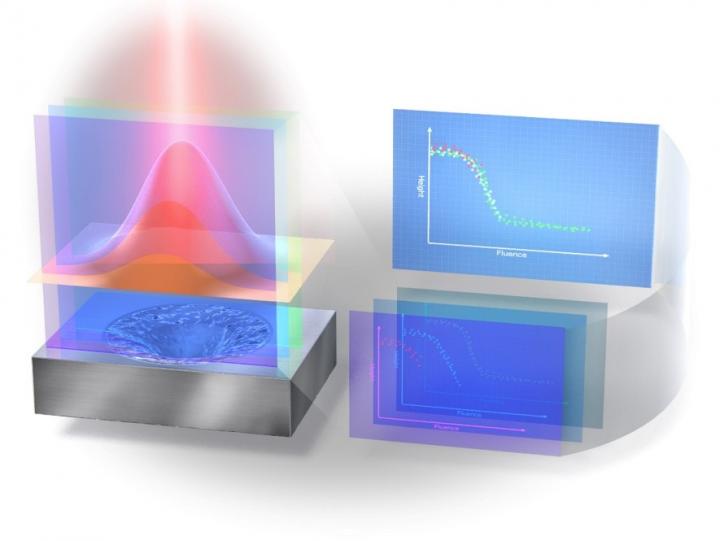A new way to observe laser interactions could improve laser-based manufacture

Credit: © 2021 Sakurai et al.
Despite the enormous amount of research over the decades into lasers and their applications, there have been few ways to accurately, efficiently, and directly observe fine details of their interactions with materials. For the first time, researchers have found a way to acquire such data from a production laser using low-cost equipment that could vastly improve the accuracy of items cut or etched with lasers. Given the ubiquity of lasers, this could have wide-ranging implications in laboratory, commercial and industrial applications.
Lasers are used in an extraordinarily wide range of applications in the modern world. One area in particular that is increasingly important is in manufacture, the reason being the level of precision at which a laser can operate is far greater than that of the equivalent physical tool. However, this level of precision could be even higher in theory, leading to a new generation of yet unimagined technologies. There are some hurdles to overcome, though. One significant way in which laser precision could be improved is if there was a better means to obtain feedback on the way the laser interacts with a material. That way, there would be greater control and less uncertainty in the cutting and etching actions of a production laser. This problem has proven surprisingly difficult to tackle until now.
“To measure how far into a surface a laser has cut often requires tens or hundreds of depth readings to take place. This is a substantial barrier for fast, automated laser-based production systems,” said Professor Junji Yumoto from the Department of Physics at the University of Tokyo. “So we have devised a new way to determine and predict the depth of a hole produced by laser pulses based on a single observation rather than tens or hundreds. This finding is an important step forward in improving the controllability of laser processing.”
Yumoto and his team wondered how to determine the depth of a laser hole using the minimal amount of information possible. This led them to look at what is known as the fluence of a laser pulse, which is the optical energy the pulse delivers over a given area. Until recently, expensive imaging apparatus would have been required to observe this fluence, and this usually lacked sufficient resolution. But thanks to developments in other areas of electronics and optics, a relatively simple Raspberry Pi Camera Version 2 proved ample for the job.
As their test laser apparatus made a hole on sapphire, the camera recorded directly the fluence distribution of a laser pulse. Then a laser microscope measured the hole shape. By superimposing these two results and using some modern numerical methods, the team produced a large and reliable data set that could accurately tell you the relation between fluence and hole depth.
“This would be correspondent with the extraction of about 250,000 data points from a single measurement,” said Yumoto. “Our new method could efficiently provide big data for machine learning and new numerical simulation methods to improve the accuracy and controllability of laser processing for manufacture.”
###
Journal article
Haruyuki Sakurai, Kuniaki Konishi, Hiroharu Tamaru, Junji Yumoto, & Makoto Kuwata-Gonokami. Direct correlation of local fluence to single-pulse ultrashort laser to ablated morphology. Communications Materials.
https:/
Funding and support
This work was supported in parts by MEXT Leading Graduates Schools Program, Advanced Leading Graduate Course for Photon Science (ALPS), MEXT Quantum Leap Flagship Program (MEXT Q-LEAP) Grant Number JPMXS0118067246, the Center of Innovation Program funded by the Japan Science and Technology Agency (JST), and the New Energy and Industrial Technology Development Organization (NEDO) project “Development of advanced laser processing with intelligence based on high-brightness and high-efficiency laser technologies (TACMI project).”
Useful links
Graduate School of Science
https:/
Gonokami-Yumoto group
http://www.
Related Q-LEAP project
https:/
Related NEDO project
https:/
Research contact
Professor Junji Yumoto
Department of Physics, The University of Tokyo,
7-3-1 Hongo, Bunkyo-ku, 113-0033 Tokyo, JAPAN
Tel: +81(0)3-5841-4082
Email: [email protected]
Press Contact
Mr. Rohan Mehra
Division for Strategic Public Relations, The University of Tokyo
7-3-1 Hongo, Bunkyo-ku, Tokyo 113-8654, JAPAN
Email: [email protected]
About the University of Tokyo
The University of Tokyo is Japan’s leading university and one of the world’s top research universities. The vast research output of some 6,000 researchers is published in the world’s top journals across the arts and sciences. Our vibrant student body of around 15,000 undergraduate and 15,000 graduate students includes over 4,000 international students. Find out more at http://www.
Media Contact
Professor Junji Yumoto
[email protected]
Original Source
https:/
Related Journal Article
http://dx.




